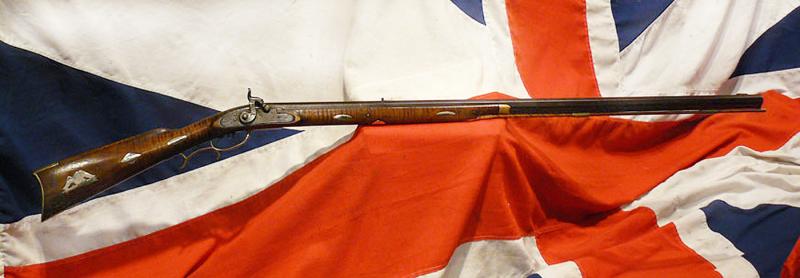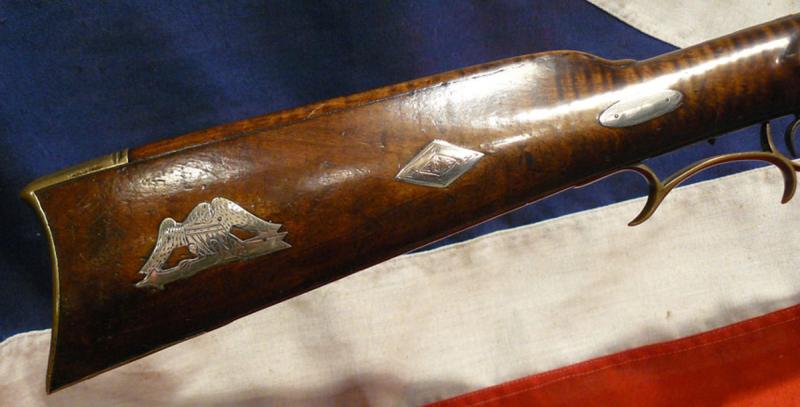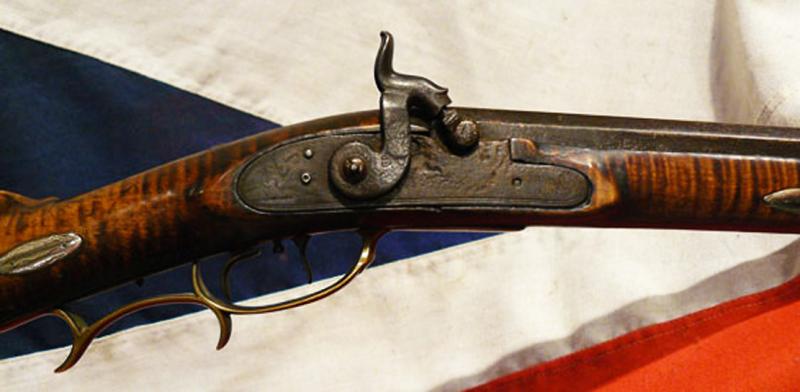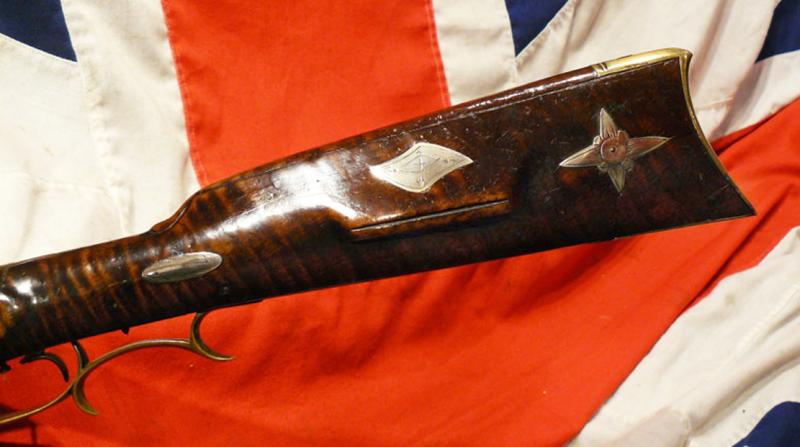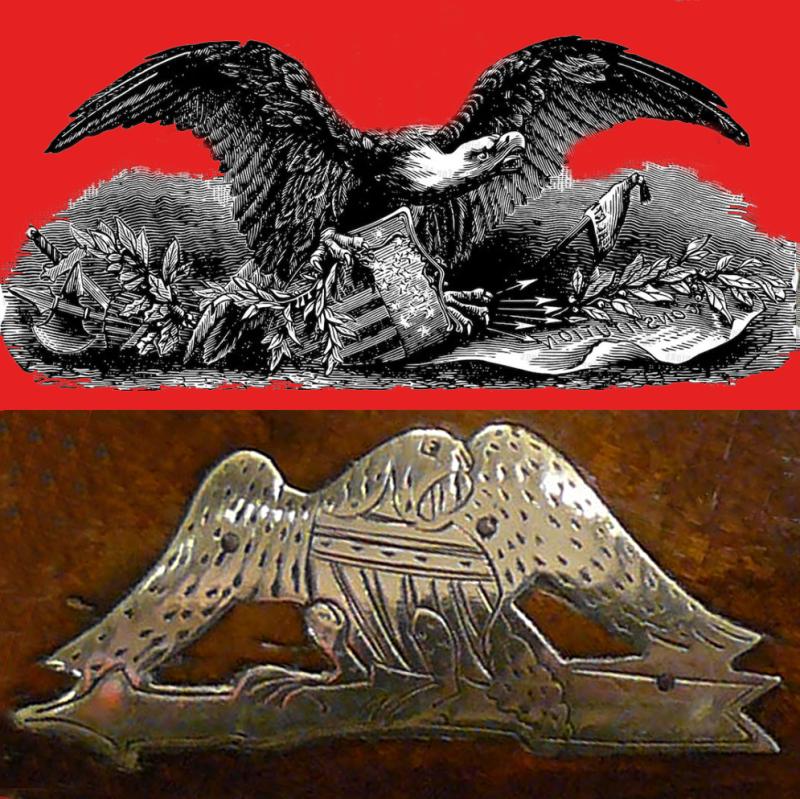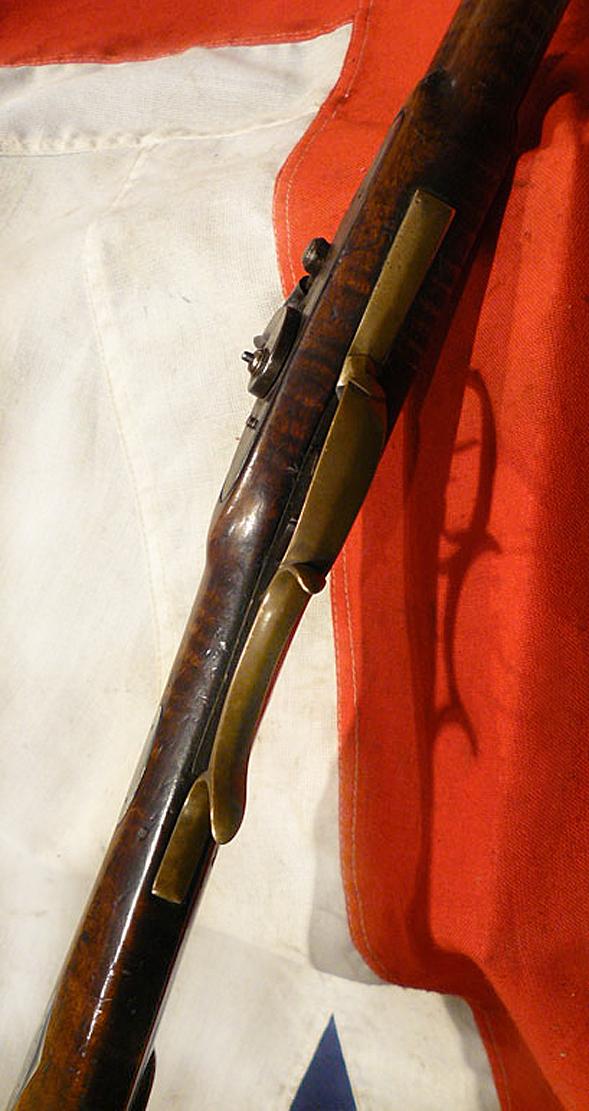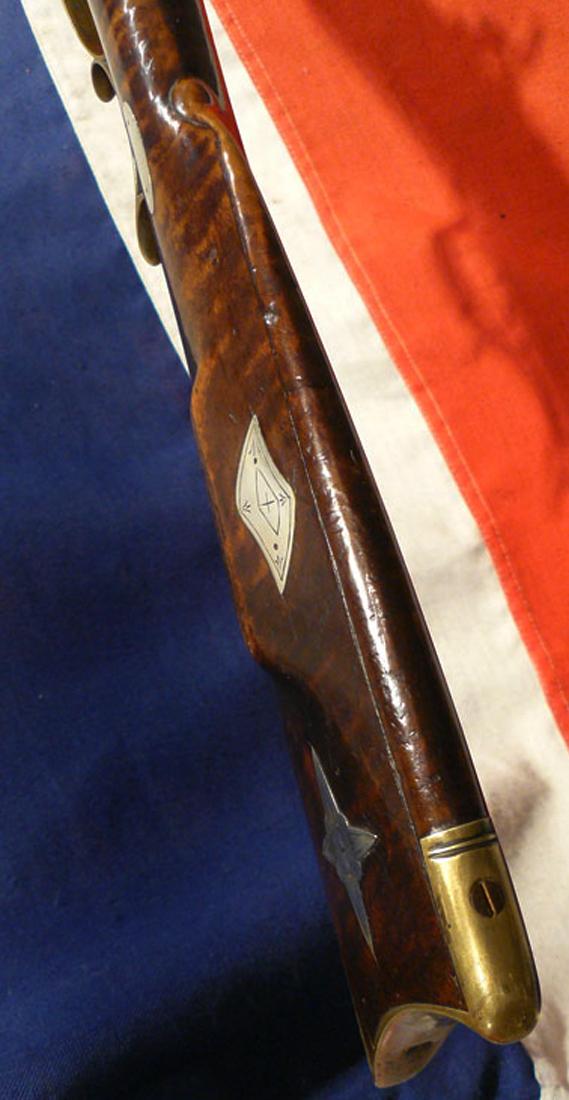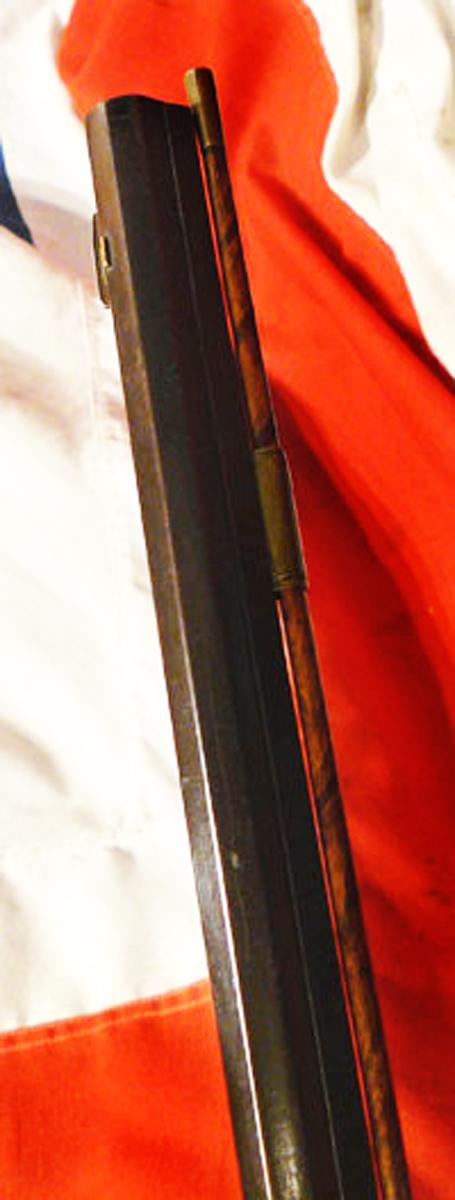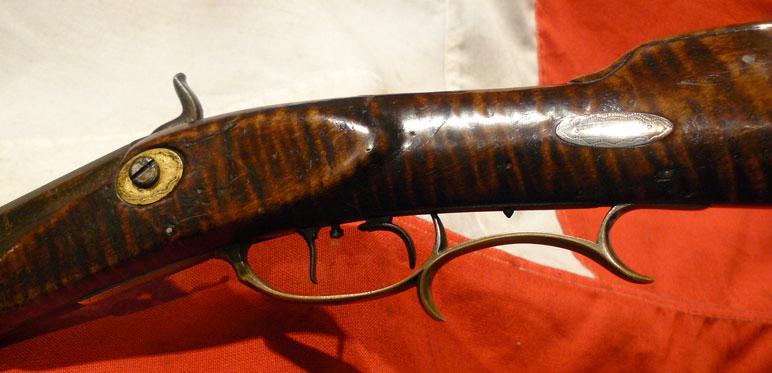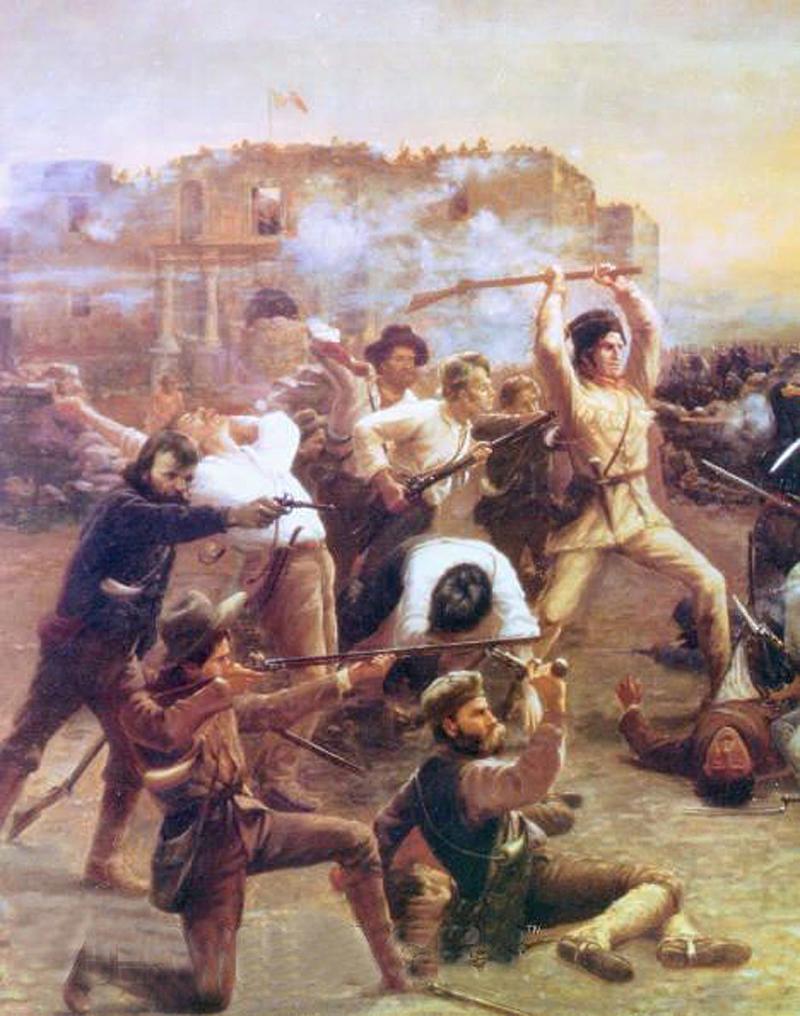American 1830's Kentucky Plains Rifle of Classic Hawken Type, Set Trigger Action and Early American Eagle Silver Inlays. Made and Used in the Era of The Siege of The Alamo by The Texian Riflemen
Of course many of the Texians at the Alamo were of course volunteer backwoodsmen, pioneers and hunters, from many different American States. Men who put their lives on the line, once more, in order to aid their Texas friends, realising it may {in fact, it did} be the very last battle they were to fight for their common principles and cause. Recognised as Texas heroes, despite wherever they originally travelled from, in order to die for Texas.
Tiger stripe maple wood stock, traditional brass fittings with various geometric shapes and an American Bald Eagle with breast flag shield standing upon a war arrow {inspired by the 1803 Indian Peace Flag} and a stylized star, {which may have represented Texas statehood ambitions}, plus numerous ovoid and shaped engraved panels inlaid. Striped wooden ramrod. Set trigger action. Elongated trigger guard, crescentic butt form, with overall superb patination.
The 'Kentucky Rifle' and the Plains Rifle were probably the most famous, and certainly the most beautiful rifles ever made in America's long history of fine arms making. They was used to incredible effect by the backwoods and mountain men in the American Revolutionary War, and by Congressman and Tennessee hero Davy Crockett and his riflemen, in the Creek Indian War, in 1813, and, at The Alamo.
The Alamo was the famous siege and battle valiantly fought by the Texican volunteers against Mexican forces, under the despotic General Santa Anna, in 1836.
This is the very rifle as was used by Davy Crocket and his Texian riflemen volunteers.
The Battle of the Alamo (February 23 – March 6, 1836) was a pivotal event in the Texas Revolution. Following a 13-day siege, Mexican troops under President General Antonio López de Santa Anna reclaimed the Alamo Mission near San Antonio de Béxar (modern-day San Antonio, Texas, United States), killing the Texian and immigrant occupiers.
Santa Anna's cruelty during the battle inspired many Texians, both legal Texas settlers and illegal immigrants from the United States, to join the Texian Army. Buoyed by a desire for revenge, the Texians defeated the Mexican Army at the Battle of San Jacinto, on April 21, 1836, ending the rebellion.
This fine gun has a superb, long, very heavy barrel, traditional crescent butt, a percussion action, and a beautiful tiger-stripe maple half stock, wonderfully set with tradition American rifle brass fittings with silver inlays. All fine brass traditional Kentucky rifle furniture mounts with fairly plain lock. It was the early American long guns that were shown to great effect in the film 'The Patriot' the award winning film of the American Revolution. The back country riflemen of the Carolinas and the Mountains of Virginia confounded the British due to their weapons accuracy and long range effectiveness, these were true beginnings of guerrilla warfare which influenced the British decision to create the Rifles Regiments of skirmishers. Early in the conflict gunsmithing was placed under virtual control of the Continental Congress, which fixed the prices for guns and decreed that gunsmiths deliver all guns to the patriot army or be branded as enemies and deprived of the tools of their trade. Pennsylvania makers helped materially to supply the nine companies of riflemen that were raised in this State and placed initially under the command of Colonel William Thompson of Carlisle. The defeat suffered by the riflemen under Benedict Arnold in the ill-fated attack on Quebec was avenged somewhat by the later victories at Saratoga and at King’s Mountain, where the “Tomahawks” comprised a large part of the American forces. Major Patrick Ferguson, commander of loyalist American troops fighting for the British army, who was killed by a rifle bullet at King’s Mountain, had his unit experiment with a breech-loading rifle of his own invention at the battle of the Brandywine. He had urged its adoption by the British army, but the musket continued to be used commonly by all European armies until well into the nineteenth century. The bloody repulse of the British at New Orleans early in January 1815 by the men of Tennessee and Kentucky under Andrew Jackson’s command is another epic in the saga of this historic firearm.
Westward across the plains, over the mountains, and beyond the sunsets it was carried by hunter, trader, prospector and settler. Indians respected the “fire stick” and learned to use it against the white intruders in many forays that chronicle the struggle for the West.
To the South and West the United States national domain was in part carved out by the use of the Kentucky-Pennsylvania type gun in the war with Mexico. Some of the information we detail was from the Pennsylvania Historical and Museum Commission and for information and education purposes only.
One of those generic rifles, a Pennsylvania long rifle, was plucked from the ashes by a Mexican citizen of San Antonio who decided to keep it as a memento of the slaughter. The rifle was later given to Frank Johnson, a Texian that had left the Alamo before the siege began. The rifle then changed ownership several more times over the decades until 1947 when it finally ended up back where it belonged, in the Alamo museum.
That specific Pennsylvania rifle, known by many names but most commonly as a Kentucky long rifle, is the only firearm in the Alamo museum today whose provenance can be traced directly back to the battle. However, it is a certainty that it is not the only long rifle to have been fired during the siege.
The long rifle was a specifically American invention, developed in the 1700s for hunting the western wilderness of the early colonies. It could fire accurately well in excess of 200 yards thanks to the revolutionary spiral grooving in the bore developed and perfected by Germanic immigrants to Pennsylvania.
Suited to its owner, it could be 4 to 6 feet long and was available in calibers from .25 to .62. They remained the most effective and popular rifles for decades, crossing all class barriers. It is undeniable that a great number of these rifles, as well as matching calibered flintlock pistols, found their way south to the Texas colonies in great numbers.
Weight, approx 8 pounds. Overall length 54.5 inches, barrel 38.75 inches, barrel thickness 1.00 inch wide overall. Like all our guns, it is a non-restricted antique collectable with no licence required to own or buy. Last picture in the gallery is of the fall of the Alamo and the Kentuckians
Code: 24961
Price
on
Request

